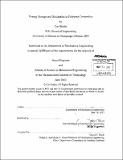Energy storage and dissipation in polyurea composites
Author(s)
Bodin, Carl (Carl Kenneth)
DownloadFull printable version (17.61Mb)
Other Contributors
Massachusetts Institute of Technology. Department of Mechanical Engineering.
Advisor
Mary C. Boyce.
Terms of use
Metadata
Show full item recordAbstract
Polyurea composites have been of interest for a variety of engineering applications via their highly dissipative yet resilient behavior under deformation. Polyurea composites have been considered as a self-healing and anticorrosion coating in building applications, and more interestingly, as a lightweight addition to steel armor. In combination with a metal plate, a polyurea layer has been extensively studied under impact and blast loading. In this research, the tunable performance of polyurea sandwich armor composites is explored in modeling and experimentation. Cylindrical arrays comprised of polyurea, a resilient yet dissipative material, enable improved load transmission by utilizing new dissipation and storage pathways due to geometry. Experimentation and computational modeling are used to quantify the dissipation features of the polyurea composite. This research combines a new polyurea interlayer geometry with steel to improve the composite armor blast performance by increasing energy dissipation.
Description
Thesis (Nav. E. and S.M.)--Massachusetts Institute of Technology, Dept. of Mechanical Engineering, 2013. "June 2013." Cataloged from PDF version of thesis. Includes bibliographical references (p. 87-89).
Date issued
2013Department
Massachusetts Institute of Technology. Department of Mechanical EngineeringPublisher
Massachusetts Institute of Technology
Keywords
Mechanical Engineering.